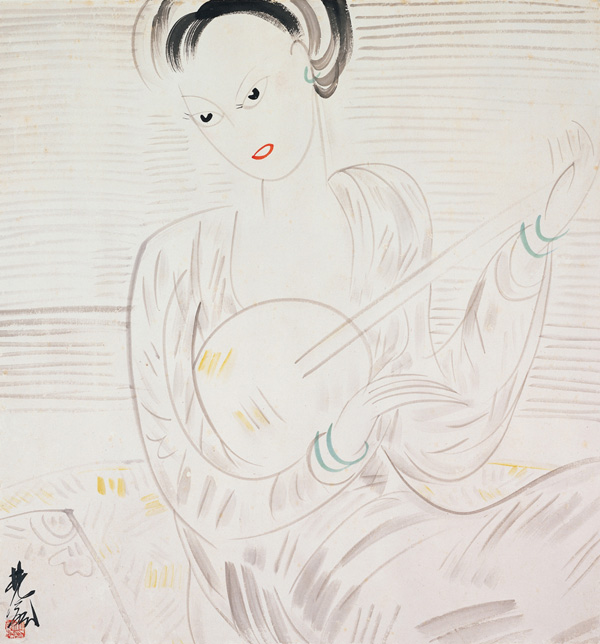The "Lady Playing Moon Guitar"comes from the collection of Lin Fengmian's daughter Lin Di-na (Dino Terese Markowitz). Lin Di-na was the daughter of Lin Fengmian with his second wife Alice Vattant, who was from France. Born in 192772 at Nanjing, she was quite beautiful with both Chinese and French ancestry. For 29 years Lin Di-na lived in the Lin household with her parents. In 1956 Lin Di-na and her mother were given permission to leave Shanghai and they settled in Brazil with her Brazilian husband. Later she moved to Europe. Ling Fengmian however did not choose to accompany his wife and daughter, choosing to remain behind in Shanghai by himself, perhaps because he was uncomfortable with the different languages and customs. After parting with his wife and daughter in 1956, he went on to experience the tragedies of the era before finally being re-united with them 22 years later. When he lived alone in Shanghai, Lin Fengmian rarely left his home and spent almost all of his time buried in his art work. Prominently displayed in his living room was a portrait of his daughter that a student had painted for her 20th birthday. Lin Fengmian once took a photo with the portrait behind him, and on the back of the photo he wrote a line from Li Shu-tong's poetry: "Happy reunions are rare in life, but partings all too often" This was then mailed to Lin Di-na in faraway Brazil, the line expressing his deep sense of sorrow. When Lin Di-na departed in 1956, she took with her a selection of her father'sart works, and this painting was one of them.
It was said that many of the elegant ladies that appear in Lin Fengmian's paintings drew upon his daughter for their inspiration. The slim and exquisite woman depicted in "Lady Playing Moon Guitar"is the exact image of Lin Di-na. The young girl in a fashionable outfit, the slim form outlined in ink and the pale colors applied to the bracelet and background completely bring to life the image of an elegant modern lady. The lady portraits from Lin Fengmian' s later periods nearly all show their subjects in traditional outfits, with ladies in modern fashions no longer making an appearance. According to art historian Lang Shao-jun' s analysis, the painting of stills lifes, modern ladies and female nudes that appeared towards the end of the 1940' s were " a reflection of the subtle changes in Lin Fengmian's daily life and artistic pursuits after his return to Huangzhou. The cultural nationalism that had appeared in the art world during the War of Resistance showed clear signs of waning during this period. The desire for democracy, individuality and introduction of Western influences were once again on the rise. The stills and modern lady paintings reflected the artist's transition from tradition and inks to colors and modernity. Set against the artist's return to school as well as the overall trends in society of that time, this transition made sense"(Lang Shaojun, Chinese Celebrated Painters 9 - Lin Fengmian, Artist Publishing Co., Taipei, March 2004, pp. 92-93)"
Though the woman in the "Lady Playing Moon Guitar"is in Western dress, her appearance such as the eyebrows, almond eyes and cherry-like mouth were however from the archetypes of beauty in traditional Chinese literature. The "Moon Guitar" is a traditional Chinese musical instrument. The earliest record of the lady playing moon guitar theme in Chinese traditional art dates back to the Tang dynasty, with frescoes of performing musicians at the Dunhuang Caves. During the War of Resistance against Japan and his retreat to Chongqing, Lin Fengmian would have certainly seen the famous exhibition of Dunhuang frescoes paintings made by Chang Da-chien. During the early 1950's he himself experimented with painting from the Dunhuang frescoes. What Lin Fengmian actually sought was not to follow the path of Chinese painting. The musical performance theme was in fact used as a research topic for creating new art, and it was his intention to create a style of art that surpassed Henri Matisse in theirit' s novelty. He retained the outlining technique and the open face of traditional ladies from Chinese paintings, but for the subject's form and lines within the composition of the painting, as well as the use of the decorative background, he infused elements of modern Western art. The results were portrait paintings so characteristic of Lin Fengmian individual style.
The creative period for portraits of ladies in modern fashions like the "Lady Playing Moon Guitar"was quite short, so there are very few works of this type in existence. During the 1950's Lin Fengmian's attention switched to the exploration of characters in opera. Traditional dress became the norm for the subjects of his lady portraits, and this style continued into his final years. The modern lady portrait style can be said to be a transitory phase during which the change from traditional ink to Western colors was explored. It not only laid the foundations for the development of the artist's resplendent character portraits in his latter period, it also proved the possibility of fusing Chinese and Western schools of painting.
